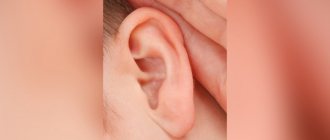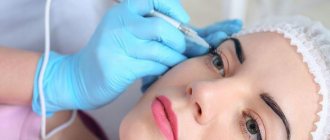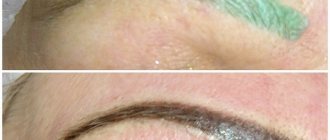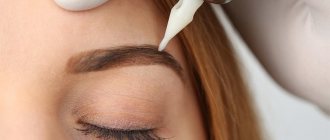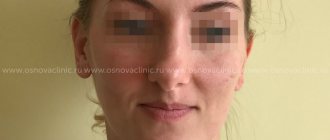Is it possible to go back to work a couple of weeks after surgery?
Experts answer this question unequivocally: it is possible. By the end of the second week, the condition of the operation area has already improved so much that it allows you to go out into the world without feeling any discomfort about the external visibility of traces of the operation.
During this time, there may still be slight bruising at the surgical site and the stitches from the incisions may not be completely smoothed out. However, experienced plastic surgeons confirm that all these marks are usually too small and poorly expressed, therefore, an outsider can only notice them with great difficulty.
Swelling after surgery usually ceases to be visible within the first week. If there are bruises in the area of the operation, it may take a little longer for them to completely disappear - from 4 to 6 weeks. In earlier stages, small traces of upper eyelid blepharoplasty during rehabilitation can be successfully hidden with light makeup. Before using cosmetics for the first time after eyelid blepharoplasty, you must ask your plastic surgeon for permission.
If the number and size of bruises are minimal, then you won’t need to hide them for a long time using makeup. Already in the second or third week you will be able to do without it.
Self-care after surgery
Follow these guidelines for caring for yourself after surgery.
- Wear dark sunglasses during your trip home. You may have sensitivity to light.
- The ointment used during surgery may make your vision blurry. This is temporary and usually goes away within 24 hours.
- Do not wear contact lenses for at least 2 weeks after surgery. You can wear glasses.
- For the first 3 to 4 days after surgery, eat small, soft foods. You can try yogurt, soft cheeses, well-cooked vegetables, soft fruits, soft bread, pasta, ground meat or soft meat.
- It is important to remain calm and quiet for the first 3-4 days after surgery. To do this: Avoid strenuous activities such as heavy lifting and exercise.
- Tell your doctor if you have nausea (the feeling of vomiting) or cold symptoms. It is important to avoid sneezing, coughing and vomiting as much as possible. This may increase blood pressure and cause bleeding in the areas where surgery was performed.
- For 2 weeks after surgery, avoid bending or lifting objects heavier than 5 pounds. Talk to your surgeon before returning to normal activities, such as heavy lifting and exercise.
Cold compresses and eye drops
Before your surgery, your nurse will show you and your caregiver how to use cold compresses and sterile saline eye drops. The nurse will also give you sterile saline solution, eye drops, and sterile gauze pads.
Follow these steps to apply a cold compress after surgery:
- Wash your hands thoroughly before applying cold compresses and eye drops.
- Make a cold compress by soaking a sterile gauze pad in sterile saline solution. You can store the bottle of saline solution in the refrigerator, freezer, or on ice.
- Apply a cold compress to your eyelids every 10 to 15 minutes (10 to 15 minutes on, 10 to 15 minutes off) for the first 24 hours after surgery. Try to do this as many times as you can while you are awake. After 24 hours, cold compresses are not as effective.
Use sterile saline eye drops if you have blurred vision or if your doctor has prescribed eye ointment. Use eye drops every 4 hours, placing them in the inner corner of the eye. Do not pull your eyelids down while using eye drops.
Showering and applying makeup
You may shower below the neck immediately after surgery. Do not shower head first until your surgeon confirms that it is safe to do so. This usually happens on the 5th day after surgery. You can gently wash the area below the eyes with a damp or soft terry cloth. You can use dry shampoo on your hair. Once you are safe to shower with your head, you can wash your eyelids and hair with a mild product such as baby shampoo.
For 2 weeks after surgery, do not apply creams or cosmetics (such as eye shadow, eyeliner, or mascara) to the areas where surgery was performed. You can use creams and cosmetics on the rest of your face.
Follow-up
Your stitches will be removed at 2 different appointments between 2 and 7 days after surgery. Your nurse will schedule these appointments for you.
to come back to the beginning
What determines the speed of rehabilitation after blepharoplasty?
Many doctors agree that the speed of recovery after eyelid surgery largely depends on the patient: how carefully and correctly he cares for his eyelids and follows the surgeon’s recommendations. Ignoring hygiene rules, non-compliance with the use of prescribed medications (ointments, etc.), excessive friction, stretching and contact with sutures can cause infection or excessive scarring, slow down the healing process of a postoperative wound, and worsen the cosmetic result of upper eyelid surgery.
In addition, with blepharoplasty of the upper eyelids, rehabilitation depends on the technique of the operation performed - what was the surgical approach, how much tissue had to be excised, etc.
Another factor influencing the results and terms of rehabilitation is the condition of the skin of the face and eyelids, as well as the general condition of the body and the presence of concomitant diseases (diabetes mellitus, kidney disease, etc.).
Preparation for blepharoplasty under local anesthesia
How to prepare for surgery on the upper and lower eyelids, circular intervention
It is necessary to stop taking blood thinners, hormonal and contraceptive medications for 2-3 weeks. At the same time, it is important to balance your diet and start taking vitamins as prescribed by your doctor. 1-2 weeks before surgery, give up alcohol and smoking. A few days before the operation, an anesthesiologist is consulted.
Fasting is indicated at least 6 hours before the procedure. On the day of surgery, do not wear makeup. Immediately before blepharoplasty and after tissue healing, the doctor takes photographs of the condition of the periorbital zone. Bring your personal and medical documents, as well as sunglasses, with you to the clinic.
Changes in eyelids depending on age
Signs of aging first appear in the upper area of the face:
- The tissue of the eyelids increases, and their outer edge sags.
- Eyebrows lower.
- Expression wrinkles appear around the eyes and on the forehead.
- Fatty hernias of the upper eyelids appear.
Patients (if they feel well) complain of an haggard appearance of the face, a sad expression in the eyes. The upper eyelids (on the outer sides of the eyes) droop, which makes it difficult for women to apply makeup and can even reduce the field of vision. Visually, the eyes become smaller, dark circles and “bags” appear under them. The problem of age-related changes in the eyes can be solved with the help of surgery on the lower and upper eyelids - blepharoplasty.
Eyelid surgery
One of the most common operations to improve appearance is eyelid surgery. It not only removes the signs of aging, but can also improve the appearance of young people. The operation is not difficult and can be done on an outpatient basis or in a hospital setting, where the patient spends 1 to 2 days. But in this case, the intervention should be carried out by an experienced specialist, because the eyelids have a delicate structure and the possibility of surgical errors should be reduced to zero.
- Swelling, hernias and bags under the eyes are successfully eliminated by lower eyelid surgery. Excess fatty tissue and skin are eliminated through an incision made under the eyelashes of the lower eyelid.
- Upper blepharoplasty is done like this: drooping upper eyelids are corrected by making an incision from the inner to the outer corner of the eyes and removing excess skin and fat. After healing, the incision becomes invisible. It hides in the crease of the eyelids.
- Combining plastic surgery on both eyelids into a single eyelid is called circumferential blepharoplasty.
- There are also such types of operations: correction of the corners of the eyes that droop with age (canthopexy), correction of the Asian shape of the eyes, treatment of exophthalmos (protrusion of the eyeball).
Within a week, preliminary results of the operation are visible, and final results are visible after about 6 months.
Important: Before surgery (10–14 days), it is recommended to stop taking pills that affect blood clotting. Patients with pathology of the ocular apparatus and visual impairment should first visit an ophthalmologist to consult about the possibility of surgery.
What to do if eyelid tattooing was done a long time ago, but blepharoplasty is needed only now
It happens that the permanent has been done for many years, but a lift is only needed now. In this case, there are two ways to get out of the situation:
- First, do blepharoplasty, then remove the tattoo or make a correction, if the shape allows. After the operation, the pattern is deformed, so in any case, correction or partial removal using a laser or remover will be required.
- First, remove the tattoo, then do blepharoplasty. It is necessary to remove the tattoo before surgery if the pigmented area falls into the scar. It will be extremely difficult to remove pigment from the area of a healed scar in the future. When the tissues heal after surgery, you can get tattooed again.
After the initial consultation, the plastic surgeon will tell you whether the old tattoo needs to be removed before blepharoplasty.
Lip contouring with fillers and tattooing
Often one cosmetology method does not help solve the problem of lack of volume, color, or symmetry. To make lips as plump as possible, two procedures are often combined: permanent makeup and lip augmentation with fillers. Moreover, they need to be done in exactly this order, since:
- hyaluronic acid may interfere with the even distribution of pigment over the skin;
- the pigment takes root less well on convex areas, which become even more pronounced after fillers;
- healing of the skin after tattooing will be faster on natural tissues;
- Correction with fillers is best done taking into account the clear contour that will appear after tattooing.
If you do the procedures in reverse order, asymmetry may appear. The larger the volume of fillers the cosmetologist introduces into the lips, the more pronounced the asymmetry will be. Especially after 5-6 months, when hyaluronic acid begins to dissolve.
It should be taken into account that when the filler stretches the skin of the lips, the pigment will become a little lighter. Therefore, the master will recommend choosing a color that is a little richer.
How to combine blepharoplasty and eyelid tattooing correctly
It is not always possible to do permanent eyelid makeup on aging skin. Over the years, thin skin in this area loses its firmness, elasticity, and sags. Ptosis develops and overhanging folds form.
If a client comes to the studio with such pronounced skin changes, our artists are forced to refuse tattooing. The procedure will not help visually remove imperfections, but, on the contrary, will emphasize them even more. On drooping eyelids, the arrows will be asymmetrical, floating, and a drooping eyelid will completely cover the area of pigmentation.
Initially, it is necessary to remove age-related skin imperfections with the help of plastic surgery: blepharoplasty, and after that, tattooing of the eyelids. With an upper or lower eyelid lift, the surgeon will remove excess skin, restore the symmetry of the eyes, and get rid of hernias. The face will become younger and more harmonious.
Blepharoplasty before permanent makeup is needed if you have:
- severe sagging of the skin;
- deep wrinkles on the lower and upper eyelids;
- excess skin in the eyelid area;
- asymmetry.
